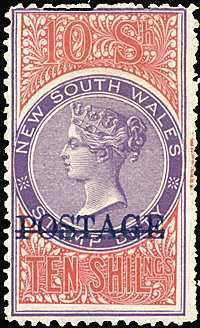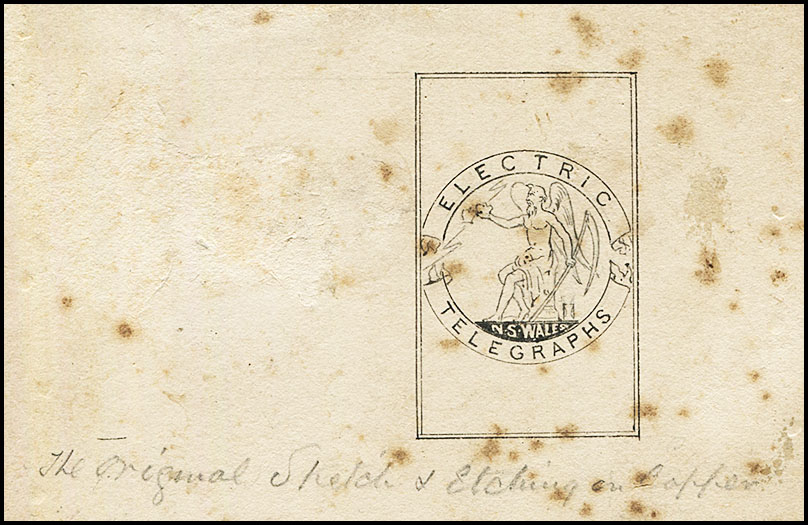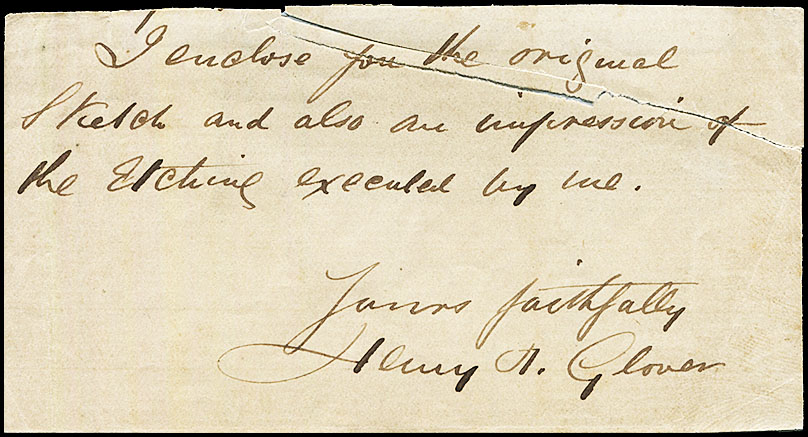The 1871 Electric Telegraph stamps - Background, Artist's essay and printing.
- Australia 1901-1988
- New South Wales
- Queensland
- South Australia
- Tasmania
- Victoria
- Western Australia
- International
- Special aspects
1. The 1871 issue of Telegraph Stamps.- lasted for about one month: the famous but rare Telegraph Stamps;
Background to the issue;
The artist's Essay for the design.
Printing the stamps.
The stamps issued.
Number of the stamps issued.
Specimen overprints.
Present stocks.
Multiples.
Used examples.
Two other attempts to use stamps to prepay telegraph charges were:
- The 1885-1886 period authorising stamp usage;
- The 1893 to Federation period using existing postage stamps
and printed transmission forms with 6d and 1/- indiciums.
In late 1870, the Superintendent of Electric Telegraphs E. C. Cracknell also noted:
"The Indian Government have lately adopted stamps for telegrams, on the same principle as postage stamps for letters. I would recommend for the consideration of the Government that the same system be tried in this Colony, as I have every reason to believe that it would prove a great public convenience, and simplify the collection of revenue".
Actually a number of countries had issued special stamps for prepayment of telegraph charges including Spain, India, Great Britain, Switzerland, France, etc.
"In 1870, it was decided to introduce the system of prepayment of telegraphic messages by means of adhesive stamps specifically prepared for the purpose".
On 20 January 1871, a notice appeared in the NSW Government Gazette:
"It is hereby notified for general information that on and after the 1st February next, stamps for the prepayment of Telegraph Messages may be obtained from Station Masters at all Telegraph Stations in the Colony.
It is desirable that in all cases, where practicable, the prepayment for Telegrams should be made by stamps.
When the system is fairly in operation, it is intended to make provision for the purchase of these stamps at several Post Offices throughout the Colony and to render the prepayment of telegrams by stamps compulsory".
Joseph Docker.
Most newspapers carried details of the issue. For example, the Yass Courier of 24 January 1871 reported the issue in the same words as above.
Bassett Hull in his 1908 book recorded the following (p. 379):
|
 An example of the Stamp Duty designs. |
The original sketch submitted by Thomas Glover is shown below together with an accompanying note signed by him.
|
|
Originally a "close-clipped" impression of the central image from an etching on copper was recorded by Bassett-Hull but nothing is now known of that.
The central circular vignette shows an allegorical figure representing "Time":
|
 |
An essay of a 4d value is also recorded (whereabouts now unknown) but there was no 4d denomination planned or issued.
The basic designs for the stamps were engraved on copper and the N.S.W. Government printer prepared three electroplates to print all values. Each plate had the images arranged in 5 rows of 10 stamps. Printing was effected in two stages:
- print the basic design (for the central vignette and framelines) by lithography from the electroplates;
- use value plates with different denominations and colours in a second pass through the printing press using typography. Unfortunately registration for the second pass was poor and so the colours are generally badly aligned.
The value plates used for the 6d design and upwards were those which had been used for the Stamp Duty printings. They had been prepared by De La Rue & Co. in London. Value plates for the 1d and 2d (denominations not required in a Stamp Duty series) were prepared in the Colony.
The stamps were all printed on bluish stamp duty paper watermarked NSW. Almost all were perf 12½ although an unknown number of sheets (very few) received perf 11. The 8/- is also known with perf 10 as well as (overprinted Specimen) with perf 13. The former perforation is unusual as machines for making a 10 perforation did not exist before 1880. It is possible that these are of "a posthumous nature". A complete set of all eight stamps with perf 10 was offered by Stanley Gibbons in September 2013 (at £4,500).
Two issues of the stamps are recorded - on 14 January and 8 February 1871. The stamps were gazetted on 20 January 1871 but discontinued in February at an unknown date and not referenced in the Annual Report, etc. The reason for the withdrawal and the ensuing silence has not been explained clearly. It is suspected that the issue of special telegraph stamps was not in accordance with the 1857 NSW Telegraph Act - and so they could be classified as illegal!!
A summary of the printings and the subsequent issue and destruction of the stamps is given in the following table:
| Action and date | 1d | 2d | 6d | 1/- | 2/- | 4/- | 6/- | 8/- |
| Printed (Dec. 1870) | 10,000 | 21,500 | 1,250 | 5,000 | 5,000 | 3,800 | 2,000 | 1,450 |
| Printed (Feb. 1871) | 15,000 | 3,500 | 2,250 | 15,000 | 10,000 | 3,700 | 500 | 1,050 |
| Total printed | 25,000 | 24,500 | 3,500 | 20,000 | 15,000 | 7,500 | 2,500 | 2,500 |
| Issued (Jan 1871) | 8,750 | 5,000 | 1,000 | 4,500 | 4,500 | 3,500 | 1,000 | 1,000 |
| Issued (Feb. 1871) | 8,000 | 8,000 | 2,000 | 5,000 | 3,000 | 1,000 | - | - |
| Total issued | 16,750 | 13,000 | 3,000 | 9,500 | 7,500 | 4,500 | 1,000 | 1,000 |
| Balance | 8,250 | 12,000 | 500 | 10,500 | 7,500 | 3,000 | 1,500 | 1,500 |
| Overprinted SPECIMEN | 100 | 100 | 100 | 100 | 100 | 100 | 100 | 100 |
| Destroyed (June 1872) | 300 | 2,000 | 150 | 100 | 350 | 150 | 1,350 | 250 |
| Destroyed (12 Feb. 1878) | 7,750 | 9,800 | 150 | 10,200 | 6,950 | 2,650 | - | 1,050 |
| Retained for record | 100 | 100 | 100 | 100 | 100 | 100 | 50 | 100 |
| Source: Records of the NSW Government Printer held in Archives Office (1/83-89) and reprinted in Hancock, p. 117. | ||||||||
The destruction of the stamps was explained in terms of "damaged during printing or after" or "being obsolete".

